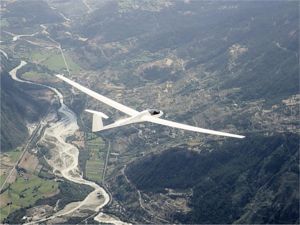PlaneSpottingWorld welcomes all new members! Please gives your ideas at the Terminal.
Schempp-Hirth Nimbus-2
| Nimbus 2 | |
| Type designation | Nimbus-2 |
| Competition class | Open |
| Number built | 243 + |
| Crew | 1 |
| Length | 7.28 m 7.33 m (after #45) |
| Height | 1.45 m |
| Cockpit width | 0.62 m |
| Cockpit height | 0.80 m |
| Wingspan | 20.30 m |
| Wing area | 14.41 m² |
| Aspect ratio | 28.6 |
| Wing profile | FX 67-K-170 / FX 67-K-150 |
| Empty mass | 345 kg (Nimbus-2 & 2b) 315 kg (Nimbus-2c) |
| Water ballast | 120-200 kg |
| Maximum mass | 580 kg (Nimbus-2 & 2b) 650 kg (Nimbus-2c) |
| Wing loading | 29 - 40.3 kg/m² (Nimbus-2 & 2b) 28 - 45.1 kg/m² (Nimbus-2c) |
| Maximum speed | 270 km/h |
| Rough air speed | 270 km/h |
| Minimum sink rate | ca. 0.49 m/s |
| Best glide ratio | ca. 47.5 |
The Schempp-Hirth Nimbus-2 is an Open Class glider built by Schempp-Hirth during the 1970's.
Loosely based on the original Nimbus HS-3 prototype, the production version that eventually surfaced as the Nimbus-2 was a very different glider with many improvements over the problematic prototype. The wing was shortened to 20.3 metres and was built in four sections to make it easier to rig and transport. It received Schempp-Hirth air brakes fitted in the upper surfaces and a tail braking-parachute, plus camber-changing flaps.
The first 132 Nimbus-2 had an all-flying T-tail similar to the Standard Cirrus as well as the general layout of it's fuselage. The later Nimbus-2b had a fixed incidence T-tailplane and elevator. The Nimbus-2c is a lighter variant with higher maximum certified flight mass, new trailing-edge combined airbrakes-flaps derived from the Glasflügel 303 Mosquito in place of the upper surface air brakes, and carbon-fibre wings and tailplane. Several other improvements took place during the production run without changes to the type designation.
The Nimbus-2 first flew in April 1971. By 1 January 1979 a total of 185 Nimbus-2, 2b and 2c had been built. A version called Nimbus-2CS was modified with a thinner wing and an increased span of 23.5m. A Nimbus-2M was also built with a retractable engine. It is based on the Nimbus-2 (not 2b) but the wing is 15cm further aft on the fuselage to make up for the C of G shift induced by the weight of the engine.
The Nimbus-2 was successful in competitions, twice winning the Open Class in World Gliding Championships. It was also popular with record-seekers. B.L. Drake, Don Speight and S.H. Georgeson jointly set a World Goal and Free Distance record of 1,254 km in New Zealand in 1978, Doris Grove a feminine Out and Return record of 1,127 km in 1981, Y. Loader a feminine Height Gain record of 10212 m in 1988, and Joan Shaw a feminine Distance record of 951.43 km in 1990, all flying Nimbus-2.
The Nimbus-2 was succeeded by the Schempp-Hirth Nimbus-3.
Sources
- Thomas F, Fundamentals of Sailplane Design, College Park Press, 1999
- Simons M, Segelflugzeuge 1965-2000, Eqip, 2004
- Sailplane Directory
- Production list
Lists relating to aviation | |
|---|---|
| General | Timeline of aviation · Aircraft · Aircraft manufacturers · Aircraft engines · Aircraft engine manufacturers · Airports · Airlines |
| Military | Air forces · Aircraft weapons · Missiles · Unmanned aerial vehicles (UAVs) · Experimental aircraft |
| Notable incidents and accidents | Military aviation · Airliners · General aviation · Famous aviation-related deaths |
| Records | Flight airspeed record · Flight distance record · Flight altitude record · Flight endurance record · Most produced aircraft |

